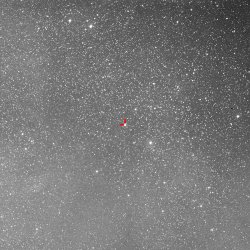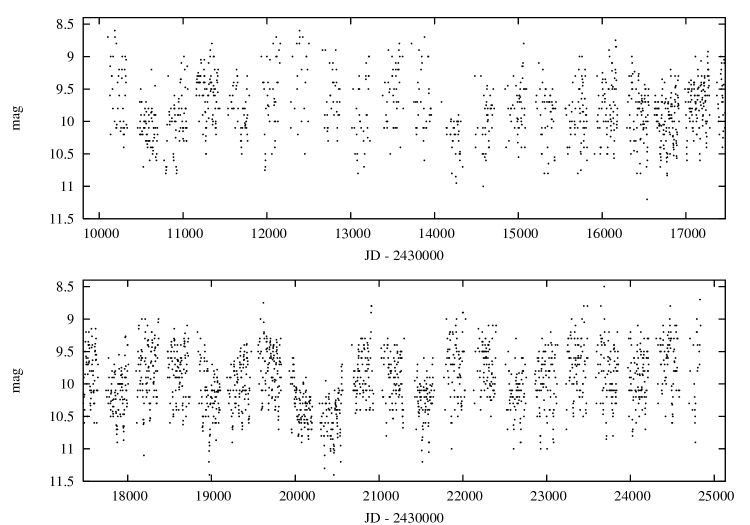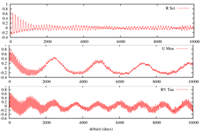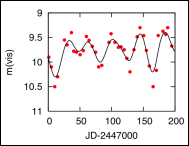RV Tauri — The strange prototype of a strange class
Our Variable Star of the Season is one of the classic variables in our skies -- the class prototype of the RV Tauri stars. RV Tau wasn't the first RV Tauri star to be discovered (the brighter variables R Scuti and U Mon came first), and it certainly isn't the brightest. But it was one of the first among them whose odd behavior made it clear these stars were a distinct class in their own right, and the curious behavior of RV Tauri over time gave it pride of place as the first of the RV Tauri variables. Since their discovery, the RV Tauri stars have piqued the interest of astronomers, drawn by their dominant feature -- being "almost" regular. Now, these stars are even more important for what they tell us about the lives (and deaths) of stars like our Sun.
Discovery
 |
| Digital Sky Survey (red plate) image of RV Tauri. FOV is 2 degrees -- equivalent to our C-scale chart. The bright star to the southwest of RV Tau is HD 30168. (click for full-sized image) |
The observational history of the important variable star RV Tauri had humble beginnings in 1905 with a simple and concise discovery paper by Lydia Ceraski (or "Mme. Ceraski" as she was often cited) announcing the discovery of three new variables from photographic plates taken by Blazhko (the other two being the Mira RY And and the Cepheid RW Cas). Ceraski derived just a handful of magnitudes from a half dozen plates, but her data made it clear RV Tauri was indeed variable, with a respectable range of over a magnitude. Following the publication of Ceraski's announcement, F.H. Seares and E.S. Haynes of the University of Missouri's Laws Observatory began observing RV Tauri on a regular basis, collecting 160 observations between November 1906 and April 1907. Their data clearly showed two things: that RV Tauri had alternating minima, and that the brightnesses of the minima seemed to be modulated in an irregular way. The alternating minima might be a sign of an eclipsing binary with unequal minima, and RV Tauri was thought to perhaps be a beta Lyrae star. But the modulation in minima suggested something else was going on.
 |
| Harlow Shapley at Harvard (From the Dorrit Hoffleit Collection of the AAVSO Archives) |
In 1916, J. van der Bilt of the Utrecht Observatory published a detailed analysis of RV Tauri photometry, and found again that the light curve showed strong evidence of irregularity. But despite the irregularity, he found statistical similarities between it and the delta Cephei stars. Although van der Bilt didn't quite grasp the variability mechanism, his comparison of RV Tauri stars with the Cepheids was right on. Today, we know that both the Cepheid variables and the RV Tauri stars are pulsating variables. van der Bilt's paper covered two other stars -- R Sgr (now classified as a Mira) and V Vul (an RV Tau) -- but the irregularity of the RV Tau light curve was more pronounced, particularly as regards the long-term modulation in maximum light van der Bilt observed. The "RV Tauri stars" were mentioned as a distinct subtype in Harlow Shapley's 1918 paper on Cepheids in clusters, and by the time Russell, Dugan, and Stewart's Astronomy was published in 1926, the RV Tauri stars were listed as a distinct class of variable star.
RV Tauri stars — variables in transition
Although RV Tauri's odd mixture of regularity and irregularity has been known since its discovery, the reasons for this behavior still aren't clear after a century. But we now know a lot about the physical nature of RV Tauri stars generally, and we have some good clues about what makes them behave the way they do. Dr. John Percy gives a good summary of what we know in his book Understanding Variable Stars, and these objects have also been the subject of several reviews over the years (e.g. Wallerstein 2002. And you should read the Variable Star of the Season articles on R Scuti and U Monocerotis too). The RV Tauri stars are known to be giant and supergiant stars, having masses close to that of our Sun, spectral types at maximum ranging from early F to late G or early K, and (probably) lower metal abundances although some are likely Population I (metal rich) stars. They are also known to be strong infrared sources, and when observed in detail, have all been shown to have substantial amounts of dust surrounding them. They are almost certainly post-Asymptotic Giant Branch stars which are in the end stages of their lives, just prior to the expulsion of planetary nebulae and their eventual contraction into white dwarf stars. When stars reach the AGB, they loop around that part of the Hertzsprung-Russell diagram in luminosity and temperature several times before finally leaving it, evolving with increasing temperature at near-constant luminosity as the star begins to shed its outer layers. It is thought that the RV Tauri stars are crossing the high-luminosity extension of the Cepheid instability strip at this time, a journey that likely lasts only a few thousand years. We are catching the RV Tauri stars during a very brief episode in their lives, and they're putting on quite a show.
The RV Tauri stars have two classifications: one photometric, and one spectroscopic. The more familiar photometric classification of RVa and RVb divides the class according to whether the stars do (RVb) or do not (RVa) have a long periodic change in maximum light. The well observed RV Tauri star R Scuti is an example of an RVa-type star with a nearly constant maximum light (around m(vis)=4.7); U Mon is an example of an RVb-type star with occasional fadings in maximum light of nearly two magnitudes (from around m(vis)=5.3 to 7.0 or fainter). RV Tauri itself is a member of the RVb subclass, with an approximate long period of around 1100 days.
The spectroscopic subclassification of the RV Tauri stars is also important, as it gives a good indication that the RV Tauri stage is (or will be) common to all low-mass stars near the end of their lives, regardless of what population they belong to. They are classified as A, B, or C depending upon both their temperature, and the presence and strength of specific molecular lines in their spectra. Class A stars are cooler stars of spectral types G and K at maximum, and whose metal abundances indicate they are old Population I (solar-like abundances). Class B and C stars are hotter stars of spectral type F; the class B stars have strong CH and CN lines indicating higher, Population I metal abundances, while the class C stars have weak CH and CN lines indicating lower Population II metal abundances. Wallerstein (2002) points out that the proper motions of the class A and B stars show they belong to the thick disk population of the Milky Way. These are relatively metal rich but old stars that formed in the disk of the Milky Way a long time ago, and have since spread out over time to orbit the Galaxy at higher elevations above the plane. The RV Tauri stars in Population II globular clusters are class C stars. If the class A and B stars really have abundances and masses like that of the Sun, then they must be quite a bit older -- evolution models of Sun-like stars show it takes about 10 billion years for a 1 solar mass star to reach the AGB. The population II RV Tauri stars probably have masses less than that of the Sun; a one solar mass star with low metal abundances will evolve faster than one with higher metal abundances, and any one solar mass Population II stars formed early in the Galaxy's history should have long since evolved to become white dwarfs.
The light curve of RV Tauri: order and complexity (and chaos?)
 |
| Light curve of RV Tauri (click for full-sized image) |
The plot to the right shows the light curve of RV Tau since JD 2440000. While there appears to be a somewhat steady pulsation throughout the entire light curve, it is by no means a strictly regular pulsator. There's a lot going on in RV Tau. The two main features are the more rapid pulsational variation with a half-period (distance between successive minima) of around 39.25 days and the corresponding full period (distance between successive deep minima) of 78.5 days. But it's obvious that this variation isn't truly regular. For one thing, the depths of minima aren't regular from cycle to cycle, which suggests either an inherent instability in the pulsation or an underlying secondary period beating against the primary period on short timescales. For another, the long term light curve shows that RV Tau is one of the RVb stars, showing a very long secondary variation of around 1100 days in the brightness of maxima.
 |
| John Percy (U. Toronto), a long-time collaborator, council member, and friend of the AAVSO |
Since RV Tau and the other RV Tauri stars aren't strictly regular, they're a bit more challenging to analyze in a statistical way than more regular stars like Cepheids, RR Lyrae stars, delta Scuti stars, and even Miras. John Percy and many students over the years have studied the AAVSO's RV Tauri stars in great detail using the statistical technique of self-correlation. Unlike Fourier analysis, which assumes an underlying periodicity in the data, self-correlation and similar autocorrelation techniques simply ask the question "How similar are points in the light curve separated by some time ΔT?" This technique lets you test whether there are specific timescales of variability present in the data that aren't necessarily present or in phase throughout the entire light curve. This plot shows the autocorrelation functions plotted for the RV Tauri stars R Scuti, U Monocerotis, and RV Tauri.
 |
| Click image to enlarge. The autocorrelation functions plotted for the RV Tauri stars R Scuti (top), U Monocerotis (middle), and RV Tauri (bottom) |
What are the autocorrelation plots showing? R Scuti is an RVa-type star, one without long-term periodic modulation in the maximum brightness. Because the light curve is somewhat irregular, points separated by more than one period become increasingly different from one another, and so the autocorrelation parameter decreases, eventually oscillating around a value of zero -- zero being uncorrelated, and (+1,-1) meaning highly correlated and anti-correlated respectively. The fact that the correlation parameter oscillates around zero with the period of R Scuti rather than varying irregularly about zero means there is still an underlying periodicity there, it just isn't in phase with itself throughout the entire light curve. U Mon and RV Tau are both RVb-type stars that do have long-term brightness modulations, and these are clear from the autocorrelation plot. Both stars show the same short term oscillation due to their pulsation periods, but they also show those broad secondary peaks, with U Mon's at about 2300 days, and RV Tau's at about 1100 days. These are due to the long-term modulation. In all cases, the fact that the autocorrelation parameter trends toward zero means that these stars really aren't periodic (at least the pulsation period isn't; the long term modulations of U Mon and RV Tau seem to hold together longer). For comparison, an autocorrelation plot of a pure sine wave, and Mira are shown here. The pure sine wave's autocorrelation plot oscillates between +1 and -1 with maxima occurring at exactly the period of the sine wave; the autocorrelation plot of Mira isn't strictly regular, but it holds together pretty well over the long term meaning it is a much more stable pulsator than the RV Tauri stars.
 |
| Short-term variations of RV Tauri |
Why do RV Tauri and the other RV Tau stars behave this way? Even after a century of observing (and much, much longer in the case of R Scuti), nobody really knows for sure. As John Percy mentions in his book, two not mutually-exclusive theories are that (a) there are multiple pulsation modes present in the star, like the fundamental and first overtone modes seen in many double-mode Cepheids, delta Scuti stars, and RRd stars, and (b) that they are showing signs of nonlinear or chaotic behavior. In 1996, former AAVSO Director Dr. Janet Mattei coauthored a paper with R. Buchler, Z. Kollath, and R. Serre showing that R Scuti's behavior met the definition of deterministic chaos -- that it wasn't regular, but that its variation was constrained by an underlying deterministic system. Their paper linked together the two-mode hypothesis and the chaos hypothesis by showing that the system was likely characterized by just two parameters -- possibly the two pulsational modes within the star.
 |
| George Wallerstein (U.Washington; photo courtesy Bob Rood, UVa) |
The reason why the star is driven to behave nonlinearly still isn't totally clear, but it's important to remember that linear pulsation theory is by definition only valid for cases where stars are subject to (relatively) small variations. It may be that the RV Tauri stars are pulsating so strongly relative to the constraints of linear theory that their regularity breaks down -- sort of like driving a pendulum to too high an amplitude and watching it behave wildly. The RV Tauri stars, like all stars in the upper reaches of the Hertzsprung-Russell diagram, are big fluffy stars whose mass is mostly concentrated deep within the star. There simply isn't much mass in the outer layers of the star, and it may be that the pulsations are so strong that they simply can't be regular at higher luminosities where there's so much energy pushing on so little mass. As George Wallerstein pointed out in his 2002 paper -- and as the paper on W Virginis that Arne Henden and I wrote in 2007 showed -- multiple mode pulsation and alternating minima seem to be fairly common among stars on the upper Cepheid instability strip, and when they're observed, alternating minima may simply be indicating the presence of two modes with resonant periods. Regular pulsators like W Vir and the beat Cepheids may lie below the threshold for unstable behavior, and the RV Tauri stars may lie above it. That's a simple explanation, and there are more complicated physical differences between the Type II Cepheid/W Vir stars and the RV Tauri stars, but from a phenomenological standpoint, the similarity in behavior may hold a clue to what's going on. Both the RV Tauri and W Vir stars are challenging targets for theoreticians performing numerical simulations, but a better understanding of these stars and their odd behavior may be coming soon.
Observing RV Tau
Despite its being the namesake of the RV Tauri class, RV Tauri isn't the brightest of the RV Tau stars, and isn't the best-observed either; both R Scuti and U Mon have longer and more complete light curves in the AAVSO archives. RV Tau also suffers more from solar conjunction than either of those stars, probably because it's fainter than either. But AAVSO observers have been following it very regularly since the 1940s, and we even have observations going back to the early part of the 20th Century, not long after it was discovered (perhaps due in small part to Harlow Shapley's influence at Harvard).
RV Tau is perfectly placed for northern hemisphere observers during the northern winter months, at RA 04:47:06.7 , Dec +26:10:46 (J2000). Right now (mid-January) it never gets lower than an airmass of 2 until the early morning for most of the northern hemisphere. It's a bit lower in the north for southern observers, but at +26, it is still well within range of most everyone. The higher distance from the ecliptic means observers can in principle push a little bit closer to solar conjunction than either R Sct or U Mon. The annual gaps are almost but not quite gone, and it would be great to see observers catching RV Tau in twilight come the middle of 2009! RV Tau and its comparison stars are all in VSP, and you can print out custom charts to suit your needs. (Note that RV Tau is fainter than the default faint limit of A-scale charts, so you'll need to use B-scale charts or lower the A-scale magnitude limit to 11 or fainter to catch RV Tau and its comparison stars.) RV Tau is one of the spectral class-A stars, so you'll likely find it slightly red, particularly at minimum when it reaches spectral type M2. It varies between approximately 9.5 and 13.5, making it a good target for telescopic visual observers throughout most of its range.
RV Tauri is a fascinating star, and like all the stars of the class that bears its name, it remains a mystery a century on from its discovery. AAVSO observers have done a wonderful job covering this important star, and we encourage all of our observers -- new and experienced, visual and CCD -- to give RV Tauri a look. An answer to the mystery of the RV Tauri stars may come soon, and the more data we have, the better!
For further reading
- Malatesta, Kerriann, AAVSO Variable Stars of the Season: R Scuti and U Mon
- Percy, John, Understanding Variable Stars (Cambridge: Cambridge Univ. Press)
- Percy, J.R. & Coffey, J., 2005, "Period Changes in RV Tauri and SRd Variables," JAAVSO 33, 193
- Percy, J.R., Hosick, J., & Leigh, N.W.C., 2003, "Self-Correlation Analysis of RV Tauri Stars and Related Objects," PASP 115, 59
- Percy, J.R. & Bakos, A., 1998, "AC Her and U Mon: RV Tauri Stars in the AAVSO Photoelectric Photometry Program," JAAVSO 26, 112
- Percy, J.R. et al., 1997, "The Nature of the Period Changes in RV Tauri Stars," PASP 109, 264
- Percy, J.R., Csatary, A., & Zorgdrager, I., 1992, "Period Changes in RV Tauri Stars: Observations and Simulations," JAAVSO 21, 86
- Percy, J.R. et al., 1991, "Period changes and evolution in RV Tauri stars," ApJ 375, 691
- Veldhuizen, T. & Percy, J.R., 1989, "Evidence for chaotic behavior in R Scuti?", JAAVSO 18, 97
- Broens, Eric, 2007, "A different view of RV Tauri stars", Eyepiece Views #321
- Buchler, J.R., et al., 1996, "Nonlinear Analysis of the Light Curve of the Variable Star R Scuti", Astrophysical Journal 462, 489
- Preston, G.W. et al., 1963, "A Spectroscopic and Photoelectric Survey of the RV Tauri Stars", ApJ 137, 401
- Seares, F.H. and Haynes, E.S., 1908, "The Variable RV Tauri (45.1905)", Laws Observatory, University of Missouri, Bulletin 14
- Shapley, H., 1918, "Studies based on the colors and magnitudes in stellar clusters. VIII. The luminosities and distances of 139 Cepheid variables.", Astrophysical Journal 48, 279
- Van der Bilt, J., 1916, "The Variable Stars R Sagittae, V Vulpeculae, RV Tauri, Part I: RV Tauri", Rech. Astron. de l'Obs. Utrecht, 6, 1
- Wallerstein, George, 2002, "The Cepheids of Population II and Related Stars", PASP 114, 689
This AAVSO Variable Star of the Season article was written by Dr. Matthew Templeton.

